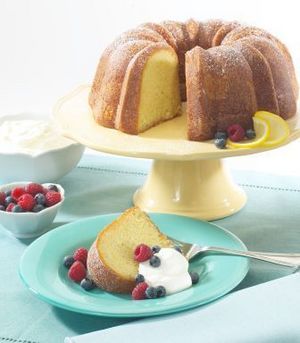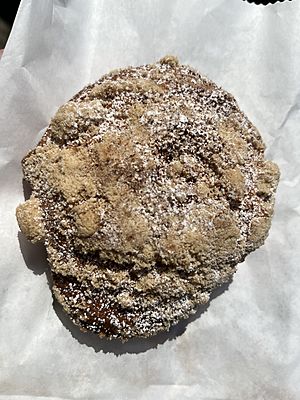Ciambella facts for kids
A Ciambella (say "cham-BELL-ah") is a delicious Italian cake. It's shaped like a ring, a bit like a doughnut, but it's usually baked, not fried. The word "ciambella" means "doughnut" or "ring" in Italian.
This sweet treat is popular all over Italy. People make it with different ingredients depending on where they live. A simple Ciambella often uses flour, sugar, eggs, milk, oil, and vanilla. Sometimes, honey is added to make it even sweeter. To make it light and fluffy, bakers whisk the sugar and eggs until they are foamy. Then, they slowly add oil and milk. Finally, flour and baking powder are mixed in, and the cake is baked in a special ring-shaped pan.
Some Ciambella cakes are made with different flours, like kamut. Instead of oil, butter can be used. You might even find versions with berry yogurt mixed into the batter! People love to add different flavors too, such as lemon, orange, chocolate, or hazelnuts. After baking, a Ciambella can be decorated with powdered sugar, pine nuts, or toasted almonds. Sometimes, it's topped with apricot jelly or pistachios.
Contents
Ciambella Across Italy
Italy has many different kinds of Ciambella. Each region has its own special way of making this ring-shaped cake. Here are a few examples:
Calabria
- Cuddrurieddru: This is a sweet, fried doughnut. It's made with flour and boiled potatoes. People in Calabria often make these tasty treats around Christmas time.
Campania
- Graffa: Another sweet, fried doughnut from Campania. It's also made with flour and potatoes. After frying, it's covered with fine sugar. It's best eaten warm and fresh, when it's super soft!
Emilia-Romagna
- Ciambella Ferrarese: This is a baked doughnut from Ferrara. It uses flour, sugar, eggs, and butter. It was traditionally a special dish for Easter.
Lazio
- Ciambella a Cancello: This one is called the "gate doughnut" because it has a fancy, detailed shape. It's made with aniseed (which tastes a bit like licorice) and local wine.
- Ciambella all'acqua: This "water doughnut" is unique! It's first boiled in water and then baked. This gives it a special texture.
- Ciambella Ellenese: A small, knot-shaped doughnut. It's flavored with cinnamon and often covered with rose water.
Marche
- Ciambella Frastagliata: This "jagged doughnut" is made with a special aniseed-flavored liquor called mistrà. It also has lots of eggs. It's boiled, then dried, cut in half, and baked until it's crispy.
- Ciambellone: This is a very traditional sweet from the Marche region. It's usually shaped like a loaf of bread. Unlike other Ciambella types, it's quite firm. This makes it perfect for stuffing with hazelnut-cocoa spread or fruit jam!
The Story of Ciambella
Ciambella is a simple but very popular sweet all over Italy. It's especially important in the Marche region. Long ago, people would eat Ciambella at big family dinners, parties, or weddings. Today, it's often served for breakfast with milk, or as a snack during the day.
There's a fun story about how the Ciambella got its famous hole! It's said that a Spanish pastry chef named Leone Ciambelli, who lived in Madrid, created the recipe. Leone was famous for his amazing cakes, especially his sponge cakes. He often won awards in baking competitions and kept his recipes a secret.
One day, before a big competition, Leone's biggest rival stole his secret recipe. The rival then sent his young son, Osvaldo, to ruin Leone's cake. Osvaldo did this by carving a big "O" (for Osvaldo) right in the middle of the cake.
Leone was very sad when he saw his ruined cake. He thought he had no chance of winning. But when the judges saw the cake with the hole, they were surprised! They thought Leone's dessert was very original and creative. Because of this, Leone won first place! In his memory, the new cake with a hole was named "Ciambella."



